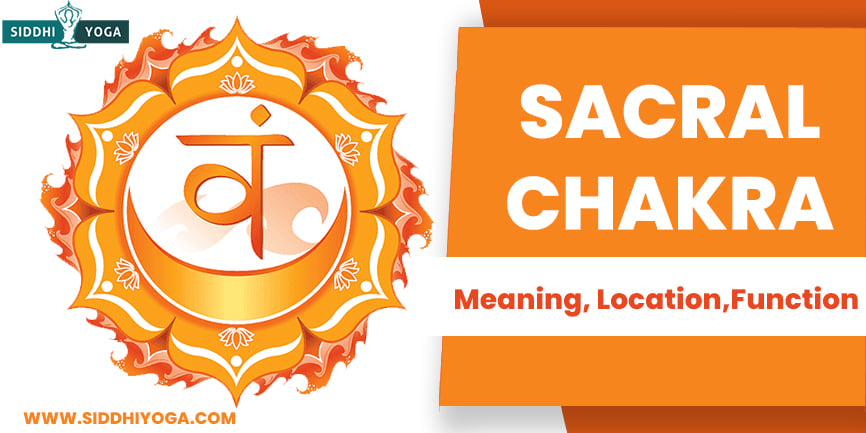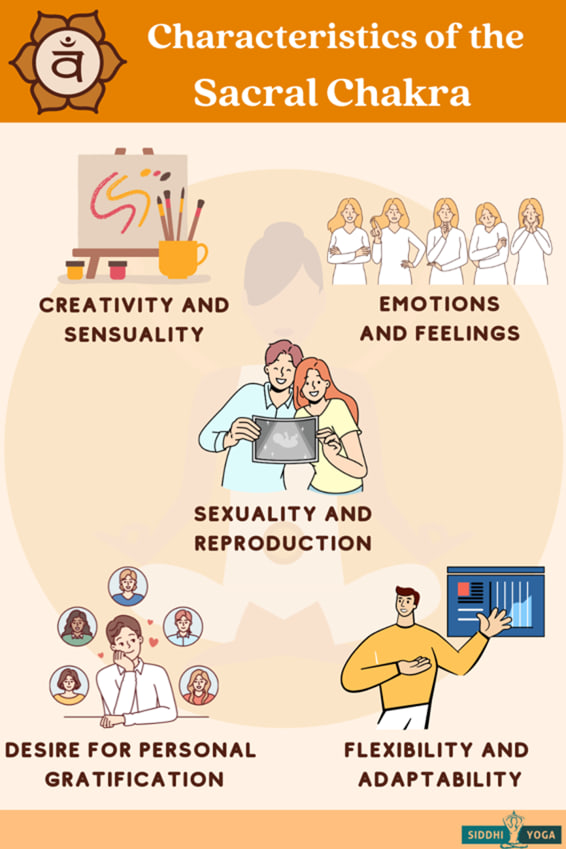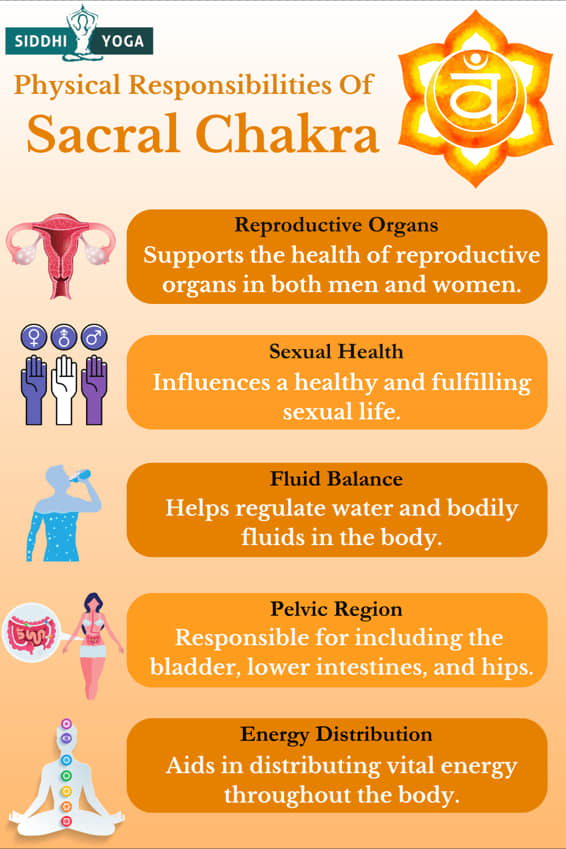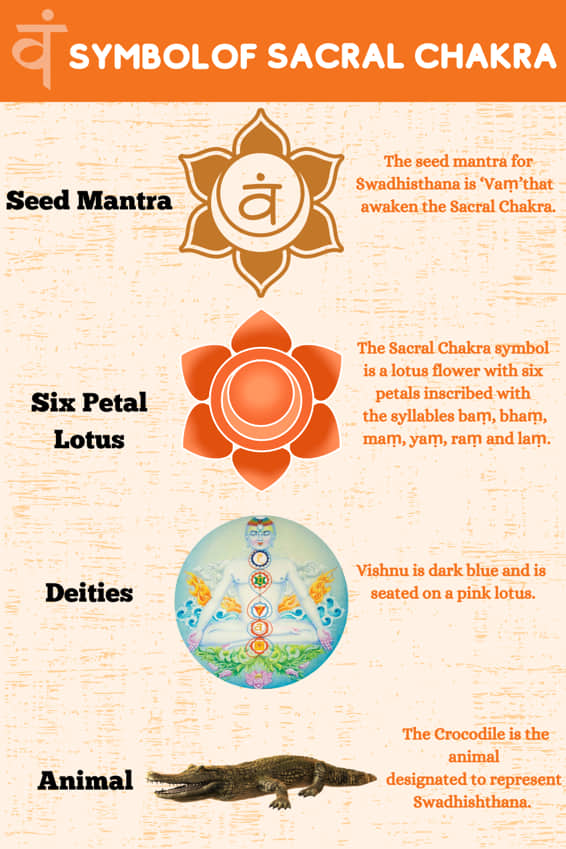
The Sacral Chakra, also known as Swadhisthana. This article will explore the meaning, functions, location and other components of this Chakra.
Introduction
Chakras are said to be the energy centres of our subtle energy body. There are seven major chakras, which are located along the spine. The history of chakras can be traced back to ancient India more than 3000 years ago. In yoga and meditation, chakras are often used as focal points for the mind.
The word “Chakra” comes from the Sanskrit word meaning “wheel” or “disk.” The chakras are the spinning wheels of energy that keep the body in balance. Each Chakra is associated with a different color, element, and function. Each is also responsible for our physical, mental, and emotional well-being when in balance. However, if any of them become imbalanced, it can lead to emotional and physical problems.
The second major Chakra in the list is the Sacral Chakra, or Swadhisthana (in Sanskrit), located in the lower abdomen, just above the pubic bone. It governs our creativity, pleasure and sexuality.
This article will explore the Sacral Chakra’s meaning, symbol, location, element, and color.
What is Sacral Chakra?
The Sacral Chakra, aka ‘Swadhisthana,’ is located at the base of your spine and helps to balance your body’s energies.
The word “Swadhisthan” comes from two Sanskrit words: swa (self) and adhisthana (firmly seated/established), in a nutshell, referring to the “sacred seat of the self.” It is located at the base parts of our body and connected to what makes us unique –our sense of imagination.
The Sacral Chakra is associated with water and is responsible for our creativity and emotions. As referred to in the ancient texts, the Svadhisthana is a place ‘where your being has been established.’ Hence this also becomes a place where the fear of death blocks access to energies in this region. The ancient yogis, or Siddhas devoted many years of practice to overcoming this fear to achieve self-liberation. They believed that the fear of death prevents a person from experiencing the higher self.
From the standpoint of everyday functioning, when this Chakra is balanced, we feel confident and connected to our intuition and sensuality. When imbalanced, we may feel creatively blocked, emotionally unstable, and disconnected from our energy.
The orange represents the Sacral Chakra; its symbol is a lotus with six petals. The element associated with the sacral Chakra is water. The main qualities of the Sacral Chakra are creativity, pleasure and flow.
Takeaway
The Sacral Chakra is known as the second Chakra. It is situated in the lower abdomen, just below the navel. This Chakra is associated with the color orange and the water element and is responsible for our creativity and emotions. When this Chakra is balanced, we feel confident and connected to our intuition and sensuality. When imbalanced, we may feel creatively blocked, emotionally unstable, and disconnected from our energy.
Main Characteristics of the Sacral Chakra

- Creativity: The Sacral Chakra is responsible for our creativity. When this Chakra is balanced, we feel inspired and motivated to create. We may also find ourselves more productive and efficient in our creative endeavors.
- Pleasure: The Sacral Chakra is also responsible for our sense of pleasure. When this Chakra is balanced, we feel joy and enthusiasm. We may also find ourselves being more spontaneous and able to enjoy new experiences.
- Flow: The Sacral Chakra is responsible for our ability to go with the flow. When this Chakra is balanced, we feel flexible and adaptable to change. We may also find ourselves being more open-minded and receptive to new ideas.
Takeaway
The Sacral Chakra is responsible for our creativity, pleasure, and flow. When this Chakra is balanced, we feel joyful, spontaneous, and open-minded. When the Sacral Chakra is imbalanced, we may experience creative blocks, emotional instability, and disconnect from our energy.
Physical Responsibilities of Sacral Chakra

The Sacral Chakra is associated with the following organs:
- The Reproductive System: The Sacral Chakra is responsible for our reproductive health. When this Chakra is balanced, we are more fertile and have healthier pregnancies or sperm health.
- The Urinary System: The Sacral Chakra is also responsible for our urinary health. When this Chakra is balanced, we may have fewer issues with incontinence and UTIs.
- The Digestive System: The Sacral Chakra is responsible for our digestion. When this Chakra is balanced, we will have fewer digestive issues.
Takeaway
The role of the physical organs in the Sacral Chakra is to help maintain your emotional, physical, and mental health. Some of these organs are the bladder, kidneys, lymphatic system, reproductive system, and large intestines.
Main Symptoms of an Imbalanced Sacral Chakra

When the Sacral Chakra is imbalanced, we may experience the following symptoms:
- Creative blocks: We may find ourselves feeling creatively blocked. We may feel like we can’t seem to get motivated or inspired.
- Emotional instability: We may find ourselves feeling emotionally unstable. We may feel like we are all over the place emotionally and can’t seem to feel settled.
- Disconnection from our energy: We may find ourselves feeling disconnected from our energy. We may feel like we are not in touch with our bodies or disconnected from the world around us.
Takeaway
When this Chakra is balanced, we feel confident and connected to our intuition and sensuality. When imbalanced, we may feel creatively blocked, emotionally unstable, and disconnected from our energy.
Sacral Chakra Color
The color orange is associated with this second Chakra, also known as the Swadhisthana chakra.
On a mundane level, Orange is the color of movement, dynamism, passion, and pleasure. It controls our sexual activities and our desires and emotions around it. That is why when it is out of balance, we may feel sexually inhibited or unable to enjoy or express our creativity fully. We may be stuck in a rut or experience depression, anxiety, excessive anger or rage.
On a spiritual level, Orange is a color associated with happiness, vitality and inspiration. It also represents purified energy in Hinduism, which may be one reason monks wear saffron-colored robes to elevate their moods through the power of meditation. Their spiritual renunciation shows that they want more out of life than just material things.
In both cases, it is all about vibrations! The frequency corresponding to the second Chakra has an energizing effect on those exposed – individuals seeking inner peace or people looking for greater well-being outside of themselves.
Takeaway
Orange is the color of passion and pleasure, representing our sexual desires. Orange also represents purity, which monks wear in their quest for spiritual knowledge.
Symbol of Sacral Chakra

- Six Petal Lotus: The Sacral Chakra symbol is a lotus flower with six vermilion petals inscribed with the syllables baṃ, bhaṃ, maṃ, yaṃ, raṃ and laṃ. The six petals of the Sacral Chakra symbolize the six things to be overcome to purify this Chakra – anger, hatred, jealousy, cruelty, desire and pride. By meditating on this symbol and internalizing its meaning, we purify and balance our Sacral Chakra, bringing greater creativity, pleasure, and vitality into our lives.
- Seed Mantra: The seed mantra for Swadhisthana is ‘Vaṃ’ – this syllable contains all of the energies of creation in its single sound vibration. This seed sound is considered a sacred syllable that can awaken the Sacral Chakra.
- Deities: Inside the Sacral Chakra flower is a white crescent moon representing water, with the deity Vishnu above it. Vishnu is dark blue and is seated on a pink lotus. He holds a conch, a mace, a wheel, and a lotus and wears the shrivatsa mark and the kaustubha gem. These marks represent infinity – and he is seated in a Padmasana pose, which signifies that he has attained spiritual perfection. His strength is the goddess Rakini, who is black and dressed in red or white. She is seated on a red lotus and holds a trident, lotus, drum and shield. She is also seated there with the representation of emitting life-giving energy. She is offered honey by her followers seeking spiritual guidance or knowledge through meditating upon kundalini energy, which leads them closer to enlightenment. Other schools of thought associate the Hindu deities Brahma and Sarasvati with this Chakra – Brahma is the creator of the manifest world, and his daughter Sarasvati is the deity of fine arts and creativity.
- Animal: The Crocodile is the animal designated to represent Swadhishthana. It symbolizes laziness, insensitivity, and danger in this Chakra – the power of water. The element’s hidden nature comes out when our emotions or thoughts negatively impact us. Our unconscious emotions are stored at the subconscious level, where they exist without control over themselves until they are stimulated. When those negative feelings rise into consciousness with nothing else holding them back any longer, we often experience its negative consequences.
Takeaway
The Sacral Chakra is the source of our emotions and desires. It’s also where we find pride, anger and desire – all things that love can overcome. It is represented by six lotus petals, the seed mantra ‘Vam’, deities Brahma and Sarasvati and the crocodile.
The Bottomline
The Sacral Chakra is in the lower abdomen, just below the navel. It is associated with the element of water and is responsible for our emotional well-being and sexuality. Its Sanskrit name is “Swadhisthana,” which means “sweetness” or “pleasure.” The color orange often represents the Sacral Chakra.
When the Sacral Chakra is in balance, we feel confident and sensual. We can express our emotions freely and enjoy our sexual relationships. We are also creative and open to new experiences. However, when the Sacral Chakra is out of balance, we may feel emotionally unstable, sexually repressed, or creatively blocked. We may also struggle with addiction or codependency issues.
To understand, heal, balance, and work with the Sacral Chakra, take our detailed course, ‘Understanding Chakras.’
